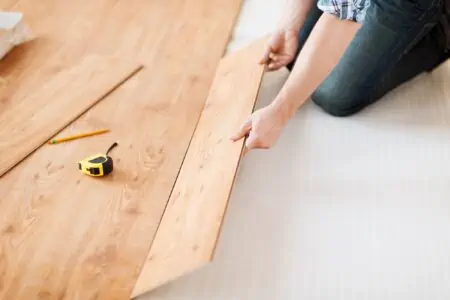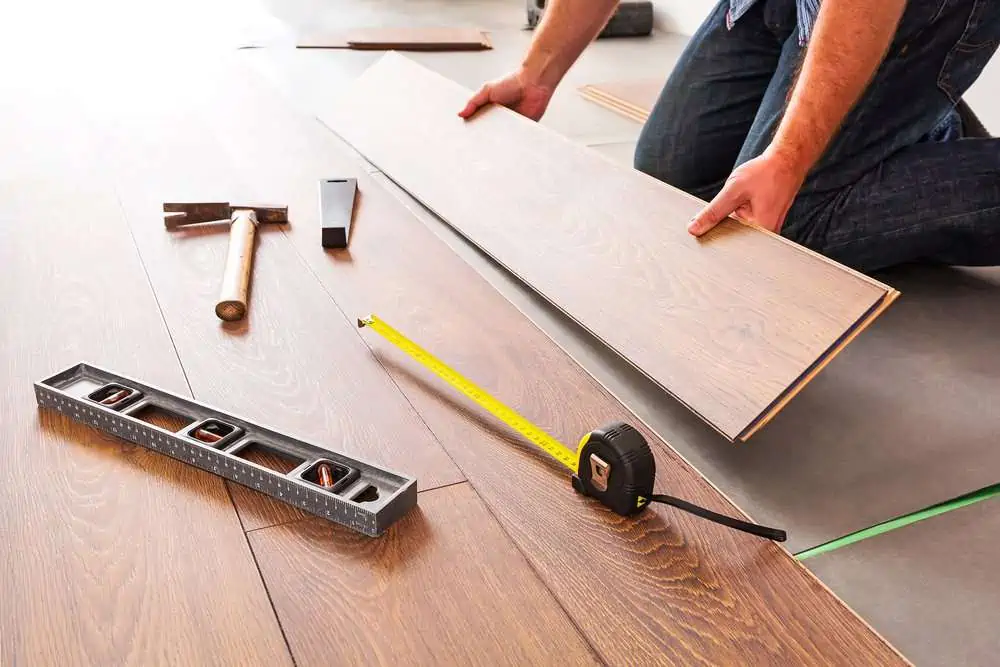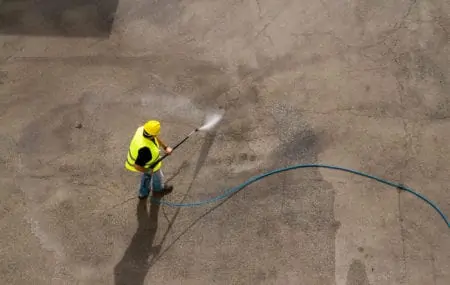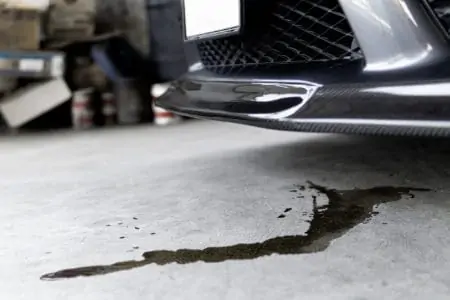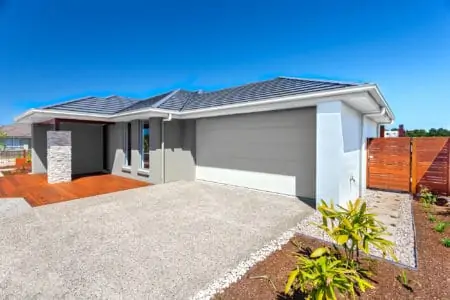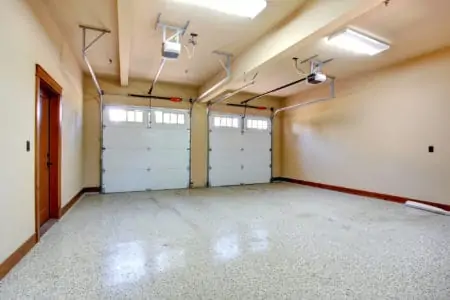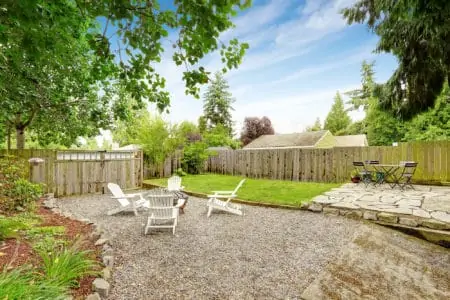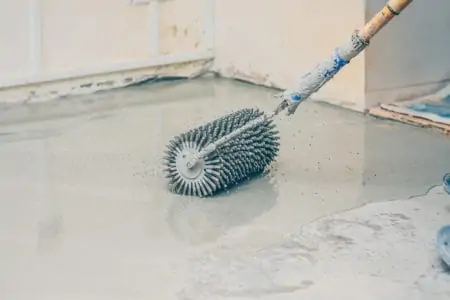It’s easy to forget that what lies underfoot is as crucial as other elements of your interior spaces. Your home would be drafty and cold without suitable flooring. A quality floor adds luxury and style and helps to create a homely feeling.
So, we think it’s time to shine the spotlight on flooring facts and statistics to bring you everything you want to know about flooring.
Key Takeaways
- The global flooring market is worth $388 billion, with the U.S. carpet market valued at $12 billion.
- Popular flooring options include hardwood, engineered wood, bamboo, laminate, and vinyl.
- Dalton, Georgia is the epicenter of the U.S. carpet industry, generating $8 billion annually in economic activity.
- Over 450 billion floors are sold globally every year, with growing interest in eco-friendly options like bamboo and cork.
Top 10 Flooring Facts and Statistics
With so many facts and data on offer, which ones did we choose as our top ten?
- The U.S. carpet market is worth $12 billion.
- The average carpet installation cost in the U.S. is $1,700.
- Vinyl flooring is most popular in kitchens and bathrooms.
- The average salary for tile and floor installers is just over $47,000.
- Dalton, Georgia, is the epicenter of the U.S. carpet industry.
- The global flooring market is worth $388 billion.
- Over 450 billion floors are sold globally every year.
- Global laminate flooring sales are estimated to be worth $78 billion.
- The global carpet industry is worth $52 billion.
- Since 2002, over four billion pounds of used and discarded carpet have been diverted from landfills and recycled.
Largest Flooring Installation Companies
Who are the big hitters in the U.S. flooring industry? Who has the biggest market share, and which companies are the most recognized? Let’s take a look at flooring sales data.
Gerflor
Gerflor is a European company established in 1973. It has a turnover of 913 million euros and employs over 4,000 people. Seventy percent of their revenue is generated in exports, especially to the United States.
The company specializes in flooring and wall solutions, focusing on vinyl and carpet flooring.
Mohawk Industries, Inc
Mohawk has its headquarters in California and has a revenue of $9.6 billion. It specializes in flooring solutions, including carpet, vinyl, and laminate. It also caters to the commercial and industrial sectors with hard flooring solutions like ceramic tiles.
As of 2018, the company has a global workforce of over 42,000 people. The company was established in 1878 by four immigrant brothers who started manufacturing carpets from a New York warehouse.
Polyflor
Polyflor is a UK-based company with a rich and illustrious history. It was established by James Halstead in 1915, specializing in producing high-quality dying, finishing, and waterproofing of textiles.
The company expanded operations into soft and hard flooring, including engineered wood and carpets. From its base in Manchester, England, it distributes to over 120 countries worldwide.
Shaw Industries
From a humble start producing bedspreads and throws, Shaw Industries started life as Star Dye Company in 1946. Fast forward to today, and the company employs over 22,000 people and has an annual turnover of $6 billion. That’s over $115 million in weekly revenue!
Flooring Facts and Statistics
It’s time to get down to the nitty-gritty and reveal what facts and data have made the list. From the bizarre to the serious, we aim to entertain and inform with our rundown of flooring information.
U.S. Flooring Market Statistics
What is the state of the U.S. flooring market, and what are the trends? Let’s take a look.
1. Carpets Sales
In the U.S., the carpet industry is worth $12 billion. That figure includes carpets as well as rugs. Compared to the global sales of $52 billion, the North American market accounts for a sizable chunk of global sales.
2. Carpet Manufacturers
If you hopped into a DeLorean and went back in time by 50 years, there would have been over 100 carpet makers in the U.S.. That number is about 20 today. Companies merge, acquire other brands, and incorporate them under their commercial umbrella.
However, Shaw Industries is the king of carpets in these here parts. They employ around 22,000 people with a turnover of $6 billion. That’s a lot of carpets!
3. Average Costs
The average price of carpet installation in the U.S. is $1,700. However, depending on the project size and the quality of the carpet, that cost could range from $800 to $2,600.
Most carpet installers charge by square foot, which can range from $3.5 to $11 per square foot, based on the quality of the product.
4. Flooring
The North American wood flooring market is expected to see a compound annual growth rate of 1.5 percent over the next five years. Currently, wooden flooring accounts for $5.2 billion, which seems low.
That’s because of the initial cost compared to other cheaper alternatives and the longevity of wooden flooring once installed.
5. Wood Flooring Installation Costs
The average price for hardwood flooring in the United States is $6.75 per square foot. This figure excludes subflooring and baseboard removal, so you will need to add $1 to $3 for additional work.
Depending on the quality of the flooring, these costs could rise as high as $23 per square foot.
6. Which Room?
Vinyl flooring has grown in popularity in the U.S., with the kitchen becoming the most likely room to benefit. This is because vinyl is easy to lay, easy to keep clean, and hard-wearing for food stains and heat.
Here’s a report of the rooms in your home that are most likely to benefit from vinyl flooring and the percentage of people most likely to use it:
- Kitchen: 47 percent.
- Bathroom: 40 percent.
- Living room: 30 percent.
- Basement: 29 percent.
- Bedroom: 23 percent.
7. Pay Day
The average pay rate for floor and tile installers in the US is $47,310 per annum, or to break it into an hourly rate, that’s $22.74 an hour. Moreover, you don’t need a formal college or university education to enter the industry.
All the training is on the job, and the scope for starting your own business and earning more is good to high.
8. People Employed in the Flooring Market
The U.S. flooring and tile market employs 117,000 as of 2022. There are forecast to be over 11,000 openings every year, so there are plenty of opportunities to get into the industry.
Growth is expected to be six percent per year.
9. Carpet Fitters
California employs the most carpet fitters by state, at 4,130. Here’s a handy chart showing the stats for other states:
| State | Employees | Employment Per Thousand Jobs | Hourly Average Wage $ | Average Annual Wage $ |
| California | 4,130 | 0.25 | 25.72 | 53,500 |
| Nevada | 1,400 | 1.09 | 25.44 | 52,910 |
| Pennsylvania | 1,370 | 0.25 | 24.23 | 50,400 |
| Illinois | 810 | 0.14 | 30.53 | 63,490 |
| Texas | 700 | 0.06 | 16.78 | 34,890 |
You can see from the chart that while California employs the most carpet fitters, it is far from the highest number per 1,000 employed people. Surprisingly, it also comes second in the pay stakes, behind Illinois by some way.
Given the cost of living in California, we thought it would top the earnings poll.
10. A Big Slice of the Pie
The U.S. carpet industry accounts for over 51 percent of the global carpet market. Almost all of it is centralized in Georgia, where 14 of the top 50 companies are located.
Georgia employs over 30,000 people in the carpet industry, generating a payroll of over $3 billion annually.
11. The Epicenter
Dalton, Georgia, is the epicenter of the U.S. carpet industry, with over 85 percent of carpet and rug makers within a 65-mile radius. It accounts for $8 billion annually in economic activity.
12. About Rugs
Over $700 million is spent on washable scatter rugs in the U.S. with a dimension of 6ft x 9ft or smaller. Non-washable hard-backed rugs of the same size account for $560 million, and room-size rugs account for $105 million annually.
Global Flooring Industry Facts
So, we’ve looked in detail at the U.S. market, but how do the global figures compare? Let’s find out.
13. How Big?
The global flooring market was worth an estimated $388 billion as of 2020. However, the market size is predicted to grow by 6.1 percent from 2021 to 2028.
14. How Many?
Over 450 billion floors are snapped up globally every year. Yep, 450 billion! Some are only replacing single rooms or segments of flooring, while others are entirely new flooring for whole buildings.
No matter the size of each individual order, 450 billion is a massive figure by anyone’s standard.
15. Hard Cash
The non-resilient (hard) flooring sector accounts for 61 percent of global flooring revenue. When you consider that the market is worth $388 billion, that’s a sizable sum.
However, while non-resilient flooring dominates sales, the resilient flooring sector has the largest projected growth from 2021 to 2027.
16. Laminate the World
In 2018, the laminate flooring market topped $63 billion globally, but today it is worth an estimated $78 billion! Its popularity is driven by its durability, sustainability, and commercial benefits.
It also has better eco-credentials than other flooring types because it is constructed largely from composite materials made from wooden waste products. This Lucida flooring is a great example of how it mimics natural wood grain.
17. Vinyl Flooring
In 2018, the vinyl flooring market was worth an estimated $25.6 billion. By 2020, it had grown to $30 billion, and at the close of 2024, it had expanded further to reach $33 billion.
This growth is expected to continue as consumers look for cheaper alternatives to cover their floors. Vinyl is easy to lay, needs minimal maintenance, and is relatively inexpensive compared to other flooring types.
18. Vinyl Growth
The growth in the vinyl floor market is expected to reach 7.4 percent over the next few years. Considering the revenue already tops $33 billion, that’s a substantial increase.
This growth is driven by the commercial and industrial sectors, which recognize the value of flooring that is cheap and great for high-traffic areas.
19. Magic Carpet
The global carpet industry is estimated to be worth $52 billion. If the trends continue, it is projected to grow to $74 billion by 2026. This equates to a CAGR of 4.6 percent between 2020 and 2026.
If you are considering entering the flooring industry, carpeting is an accessible route. The product is ready-made, you get a wide variety of prices based on quality, and fitting is pretty straightforward once you get the technique.
20. Saved from Landfill
Since 2002, almost four billion pounds of used and leftover carpet have been diverted from landfills across the country. Every year, 157 million pounds of carpet are recycled back into the flooring supply chain.
Types of Floor Coverings
With so many types of floor coverings to choose from, it’s challenging to know which is best. Here is our take on your options:
Hardwood
Hardwood flooring usually comes in cherry wood, oak, and walnut, although other materials are available. The planks are typically three-quarters of an inch thick, referred to as standard planks, so they are hard-wearing.
Hardwood flooring comes finished or unfinished. Finished means the wood has been rubbed down and treated, ready to install. You can also get wider strips that measure five to 10 inches.
Untreated wooden flooring will need sanding and treatment with a waterproof lacquer to protect it against moisture. You can expect to pay $6 to $11 for hardwood flooring per square foot, although exotic woods can cost upward of $23 per square foot.
Engineered Wood
Engineered wood is more affordable than natural hardwood. While engineered wood is cheaper, it looks like hardwood and copes with moisture better. The top layer is genuine hardwood, but the bottom section consists of multiple ply layers.
Because of its ability to repel moisture, it is a better option for areas with high humidity like bathrooms, kitchens, and basements. Unlike natural hardwood flooring, you are restricted by how often you can sand and treat the top layer.
Expect to pay between $8 and $16 per square foot, depending on the quality and brand.
Bamboo
Bamboo flooring is technically a hardwood floor, but most retailers and manufacturers place bamboo in its own category. It has comparable robustness to oak, but unlike oak, bamboo is eco-friendly.
Moso bamboo is the most popular imported Chinese flooring, and because it is a grass rather than a tree, it can grow to 70 feet high in around 60 days. It requires no pesticides, herbicides, or water to thrive, and there are no replanting costs because the roots remain.
Expect to pay between $3 and $8 per square foot, with installation costing $7 to $12 per square foot.
Laminate
Laminate is the best budget option for those who want the hardwood look but don’t want to spend big bucks to achieve it.
Laminate is essentially a composite product constructed from layers of compressed fibers with a photograph top layer that mimics wood, stone, tiles, and other designs. It has an interlocking base that connects to the next plank, so you don’t need glue or nails.
Expect to pay $1 to $7 per square foot and $2 to $5 per square foot for installation.
Linoleum
If you’re old enough, you might remember linoleum from houses in the 1970s and 80s. Today’s styles and designs are more on trend than the old patterns that your parents had.
Linoleum is considered an eco-friendly option compared to hardwood, and it comes in sheets glued directly to your floor. You can cut it around awkward shapes and corners, and it copes well with footfall and stains, making it ideal for bathrooms and kitchens.
Expect to pay $2 to $5 per square foot, but if you add in installation costs, it jumps to $7 to $12 per square foot.
Cork
Cork comes from tree bark, so the tree is unharmed in its production. The bark grows back after eight to ten years. This makes it a green option for those with environmental concerns.
You can buy cork flooring in tiles or planks, and it gives an unusual patternation with speckles and swirls. It’s made the same way as laminate, with compressed fibers on the lower layers and a top layer of cork.
Most cork flooring comes finished, but it is advisable to reseal your floor every three to five years to repel moisture. Expect to pay $2 to $5 per square foot and $3 to $5 per square foot for installation.
Tiles
Tiles are created from a mixture of clay and shale and fired in an oven at high temperatures until hard. They come in multiple sizes, styles, colors, and patterns. Floor tiles are thicker and more robust than wall tiles, so don’t try and skip on the costs and use the wrong tiles.
Keep In Mind
Tiles can offer minimal grip and slip resistance, especially when wet. This is an issue for small children and the elderly. Look for tiles with an anti-slip finish for safety reasons.
Essentially, there are four different tile types to choose from:
- Glazed ceramic.
- Quarry.
- Porcelain.
- Terracotta.
Glazed ceramic tiles offer a glass-like finish, while quarry tiles are more natural stone. Porcelain tiles come in glazed and unglazed finishes, and terracotta tiles are ideal for rustic decor.
Expect to pay anything from $1 to $100 per square foot, depending on which tile you choose. Installation costs vary between $4 and $12 per square foot.
Carpet
Carpet is a versatile option and comes in unlimited colors, patterns, and designs. It adds warmth to your room and helps to cut out drafts.
Carpet is rated on fiber density, so the more fibers per square inch, the more robust the carpet. It also makes it more expensive. Carpet is also rated on a scale of one to five on how well it copes with wear and tear. Most come in around three or four.
You can buy your new carpet in rolls or tiles and a variety of materials:
- Wool.
- Nylon.
- Acrylic.
- Polyester.
- Polypropylene.
Wool is by far the most common but also one of the most expensive options. A good choice would be to get a wool/nylon blend with a luxurious feel but without the extra cost.
Polypropylene is the best choice for indoor/outdoor carpeting because it stands up to the wear and tear of the weather. Polyester is hard-wearing and resists mold, mildew, and stains. Nylon is also robust; just be aware of static electricity. It can sometimes make your hair stand on end!
You are looking at a price tag of $2 to $8 per square foot (including installation). The underlay is another cost you need to bear in mind when fitting the carpet. That could add another $0.50 per square foot to your overall bill.
Stone
Stone flooring is an excellent choice for homes with a rustic or farmhouse feel. It looks classy and fits in well in entrance halls, kitchens, basements, and other areas where footfall and potential moisture might be a problem.
Stone tiles come in many varieties, from granite, marble (expensive), slate, limestone, travertine, and sandstone.
Top Tip
Sandstone doesn’t repel moisture like granite or marble, so you might want to reconsider laying it in the bathroom.
Softer stone flooring needs sealing every two to three years, while harder stone needs sealing every five years.
Stone flooring is one of the more expensive choices. The costs vary between $2 and $100, depending on the type of stone you choose, and $5 to $10 per square foot for installation.
Vinyl
Vinyl flooring is known for its cost-effectiveness and durability. It comes in tiles, planks, or sheets and has a cushioned back for added comfort. It comes in several designs, colors, and patterns, making it a versatile choice.
Vinyl is constructed from a patterned top layer attached to cushioned felt and foam. It works well in kitchens and bathrooms but also in basements. The upper layer is scratch and stain-resistant, and most manufacturers offer 15-year warranties.
Expect to pay $1 to $5 per square foot, depending on whether you opt for the cheap or luxury vinyl. The installation will cost an additional $1 to $4 per square foot.
Polished Concrete
Polished concrete is a relatively new trend. It comes in many patterns, designs, and colors, but you need a professional to complete the job because of the many steps involved.
Expect to pay between $3 and $12 per square foot, depending on the size and complexity of the project.
FAQs
Final Thoughts
We hope you enjoyed our floor coverings facts and statistics list and have a newfound respect for what’s under your feet. You may know some of the points here, but other information might surprise you. We bet you had no idea how big the flooring market was.
